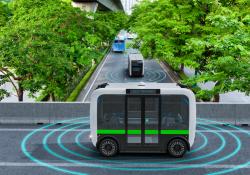The Intelligent Transportation Society of America (560 ITS America) has issued a statement following the submission of comments regarding the 2115 Federal Communications Commission’s (FCC) Notice of Proposed Rulemaking (NPRM) seeking to amend the Commission’s rules to allow for the operation of Unlicensed National Infrastructure (U-NII) Devices in the 5850-5925 MHz Band (“5.9 GHz Band”) which was set aside by the FCC for the development of connected vehicle technology.
“Motor vehicle crashes are the leading cause of death for children and young adults in the United States, with more than 34,000 fatalities on America’s roadways in 2012 alone,” said Scott Belcher, president and CEO of ITS America. “While seat belts, air bags and improved vehicle design have greatly reduced the number of fatalities resulting from traffic crashes, connected vehicle technology will take vehicle safety to the next level by giving drivers the real-time information and situational awareness they need to avoid these preventable tragedies in the first place.”
Dedicated Short Range Communications (DSRC) operating in the 5.9 GHz band is the principal enabling technology for the Connected Vehicle program, a collaborative effort between the U.S. Department of Transportation (DOT), major automakers, state DOTs and the ITS community which seeks to reduce or eliminate vehicle crashes through a fully connected transportation system uniting drivers, vehicles, wireless devices and the roadway infrastructure. DSRC provides 360 degree awareness so that vehicles can be alerted to nearby vehicles, pedestrians and potential roadway hazards and provide drivers with active safety warnings so they can avoid crashes. DSRC is the only wireless data communication system that has the requisite low latency – the time it takes data to reach its destination – with high reliability that is critical for the transmission of vehicle-to-vehicle (V2V) and vehicle-to-infrastructure (V2I) safety messages.
While ITS America recognises the potential opportunity for expanding Wi-Fi broadband through spectrum sharing with DSRC, the association raised concerns with the FCC’s proposal. ITS America cited both the importance of an interference-free DSRC platform for vehicle safety applications and noted the regulatory uncertainty created by the NPRM. ITS America is urging the Commission to affirm that it will continue to provide a stable and secure platform in the 5.9 GHz band for DSRC.
“Delayed delivery of a vehicle safety message could reduce the message’s relevance and/or validity to a vehicle crash avoidance application, and could result in preventable crashes and loss of life,” according to comments filed by ITS America.
The834 National Highway Traffic Safety Administration (NHTSA) has estimated that a fully deployed connected vehicle network could potentially address about 80 percent of crash scenarios involving non-impaired drivers, potentially saving thousands of lives each year on America’s roads. The U.S. DOT is currently sponsoring the largest on-road Safety Pilot of Connected Vehicle technology in the world in Ann Arbor, Michigan, with nearly 3,000 cars, buses, trucks and motorcycles outfitted with DSRC radio devices to test the effectiveness of V2V and V2I safety applications. These efforts are leading to an anticipated decision by NHTSA in late 2013 (for light vehicles) and late 2014 (for heavy-duty vehicles) regarding the deployment of Connected Vehicle technology.
“Motor vehicle crashes are the leading cause of death for children and young adults in the United States, with more than 34,000 fatalities on America’s roadways in 2012 alone,” said Scott Belcher, president and CEO of ITS America. “While seat belts, air bags and improved vehicle design have greatly reduced the number of fatalities resulting from traffic crashes, connected vehicle technology will take vehicle safety to the next level by giving drivers the real-time information and situational awareness they need to avoid these preventable tragedies in the first place.”
Dedicated Short Range Communications (DSRC) operating in the 5.9 GHz band is the principal enabling technology for the Connected Vehicle program, a collaborative effort between the U.S. Department of Transportation (DOT), major automakers, state DOTs and the ITS community which seeks to reduce or eliminate vehicle crashes through a fully connected transportation system uniting drivers, vehicles, wireless devices and the roadway infrastructure. DSRC provides 360 degree awareness so that vehicles can be alerted to nearby vehicles, pedestrians and potential roadway hazards and provide drivers with active safety warnings so they can avoid crashes. DSRC is the only wireless data communication system that has the requisite low latency – the time it takes data to reach its destination – with high reliability that is critical for the transmission of vehicle-to-vehicle (V2V) and vehicle-to-infrastructure (V2I) safety messages.
While ITS America recognises the potential opportunity for expanding Wi-Fi broadband through spectrum sharing with DSRC, the association raised concerns with the FCC’s proposal. ITS America cited both the importance of an interference-free DSRC platform for vehicle safety applications and noted the regulatory uncertainty created by the NPRM. ITS America is urging the Commission to affirm that it will continue to provide a stable and secure platform in the 5.9 GHz band for DSRC.
“Delayed delivery of a vehicle safety message could reduce the message’s relevance and/or validity to a vehicle crash avoidance application, and could result in preventable crashes and loss of life,” according to comments filed by ITS America.
The











